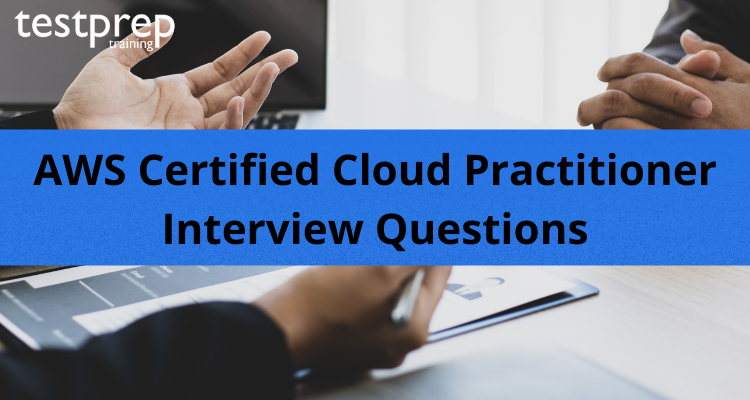AWS Cloud Practitioner (CLF-C02)


Amazon Web Services (AWS) has become the world’s most comprehensive and broadly adopted cloud platform. With over 175 fully-featured services offered from data centres globally, AWS has become the talk of the town. Moreover, millions of users including large companies, growing startups, and leading government agencies are choosing AWS to lower costs, become more agile, and innovate faster.
Not just this but AWS has also raised the bar by offering cloud certifications to validate skills of professionals as well as people who wish to build a career in cloud computing. AWS Cloud Practitioner is the stepping stone who wish to build their career in Cloud or assess their skills for better job opportunities.
Who should take AWS Cloud Practitioner (CLF-C02) Exam?
AWS Certified Cloud Practitioner (CLF-C02) exam has been built for professional with the required knowledge, skills, and abilities to demonstrate a basic understanding of the AWS platform, which includes available services and their common use cases, AWS Cloud architectural principles (at the conceptual level), account security, and compliance. You will be required to demonstrate an understanding of AWS Cloud economics which includes costs, billing, and analysis, and the value proposition of the AWS Cloud.
Skills Validated
AWS cloud Practitioner Exam validates the candidates ability to –
- Understand the value of the AWS Cloud.
- Describe the AWS shared responsibility model.
- Learn AWS Cloud security best practices.
- Follow AWS Cloud costs, economics, and billing practices.
- Understand and place the core AWS services, including compute, network, databases, and storage.
- Recognize AWS services for common use cases.
Recommended Knowledge for AWS Cloud Practitioner Exam
If you are planning to take for AWS Cloud Practitioner exam, it is suggested to have at least 6 months of experience with the AWS Cloud in any role. This may include traditional and non-traditional students, educators, and individuals exploring the AWS Cloud, including project managers, IT managers, sales managers, decision-makers, and marketers, as well as those working in finance, procurement, and legal departments. It is also suggested to have a basic understanding of IT services and their uses in the AWS Cloud platform.
AWS Cloud Practitioner Learning Path
AWS Cloud Practitioner learning path is specifically designed for candidates looking to build and validate overall understanding of the AWS Cloud. Further, this path is useful for individuals in technical, managerial, sales, purchasing, or financial roles who work with the AWS Cloud.

About AWS Cloud Practitioner Exam
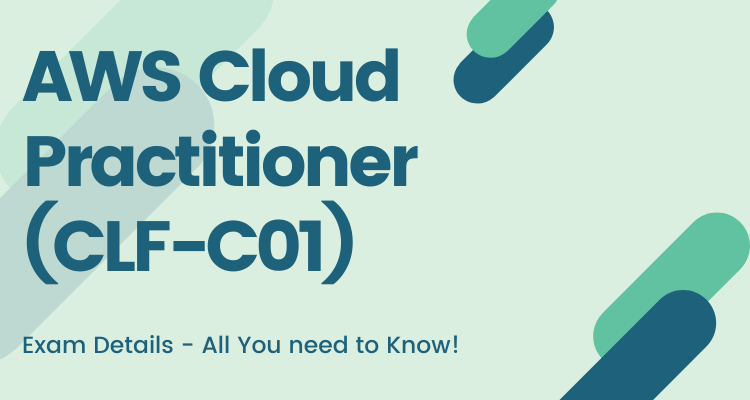
Exam Details
The AWS Cloud Practitioner CLF-C02 Exam comprises of around 65 questions. All the AWS Cloud Practitioner exam question will be either multiple-choice questions or multiple responses. However, you will only have 90 minutes to complete the examination. As for the registration fee, it is USD 100. And, the examination is available in Four different languages. Further these languages are- English, Japanese, Korean, and Simplified Chinese.
| Exam Name AWS Certified Cloud Practitioner | Exam Code CLF-C02 |
| Exam Duration 90 Minutes | Exam Format Multiple Choice and Multi-Response Questions |
| Exam Type Foundational | Number of Questions 65 questions |
| Passing Score 700 (on a scale of 100-1000) | Exam Fee $100 USD |
| Exam Language English, Japanese, Korean, and Simplified Chinese | Validity 3 years |
Exam Question Types
There are primarily two types of questions asked in the examination –
- Multiple-choice Questions: In this case, the question has one correct response and three incorrect responses (distractors).
- Multiple-response questions: In this case, the question has two or more correct responses out of five or more options.
You will be required to select one or more responses that best matches the statement to answer the question. Also, incorrect answers, are the response options that do not provide complete details or do not match with the given scenario. In general, the plausible responses that fit in the content area defined by the test objective. Note that unanswered questions are scored as incorrect. Most importantly, there is no penalty for guessing.
Unscored Content
While appearing for the exam your question paper may include unscored items that are placed on the test to gather statistical information. Such that, these items are not identified on the form and do not affect your score.
Exam Results
The results for the AWS Certified Cloud Practitioner (CLF-C02) will be given immediately on submission of the exam. The result declared will be in the form of Pass or Fail. Moreover, the exam is scored against a minimum standard that is established by AWS professionals who are guided by the certification industry best practices and guidelines.
Your results declared for the examination are reported as a score from 100–1,000, with a minimum passing score of 700. The score you obtain defines how you performed on the examination as a whole and whether or not you passed. In which case, scaled scoring models are used with an objective to equate scores across multiple exam forms that may have slightly different difficulty levels.

Score Report
The score report you obtain contains a table of classifications of your performance at each section level. Such that the information is designed to provide general feedback with reference to your examination performance. The exam uses a compensatory scoring model, which indicates that you do not need to “pass” the individual sections, only the overall examination. Also, each section of the examination has a specific weightage, thereby with sections having more questions than the other section. The table demonstrates general information, highlighting your strengths and weaknesses. You are required to exercise caution when interpreting section-level feedback.
For more queries visit AWS Cloud Practitioner FAQ
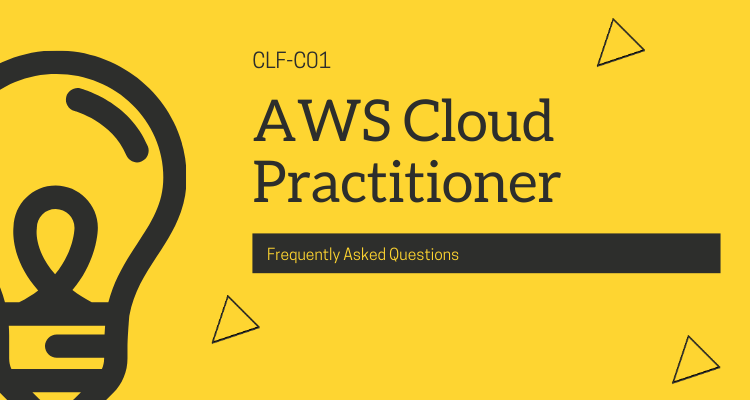
AWS Cloud Practitioner Content Outline
AWS Cloud Practitioner Exam provides a guide that includes weightings, test domains, and objectives only. It is not a comprehensive listing of the content on this examination.
We will refer some of the related AWS Cloud Practitioner Whitepapers and AWS Documentation
Domain 1: Cloud Concepts 24%
1.1: Define the benefits of the AWS Cloud.
Knowledge of:
- Value proposition of the AWS Cloud
Skills in:
- Understanding the economies of scale (for example, cost savings) (AWS Documentation: Understand the fundamentals of pricing)
- Understanding the benefits of global infrastructure (for example, speed of deployment, global reach) (AWS Documentation: Global infrastructure)
- Understanding the advantages of high availability, elasticity, and agility (AWS Documentation: High availability and scalability on AWS)
Task Statement 1.2: Identify design principles of the AWS Cloud.
Knowledge of:
- AWS Well-Architected Framework
Skills in:
- Understanding the pillars of the Well-Architected Framework (for example, operational excellence, security, reliability, performance efficiency, cost optimization, sustainability) (AWS Documentation: The pillars of the framework)
- Identifying differences between the pillars of the Well-Architected Framework
Task Statement 1.3: Understand the benefits of and strategies for migration to the AWS Cloud.
Knowledge of:
- Cloud adoption strategies
- Resources to support the cloud migration journey
Skills in:
- Understanding the benefits of the AWS Cloud Adoption Framework (AWS CAF) (for example, reduced business risk; improved environmental, social, and governance (ESG) performance; increased revenue; increased operational efficiency) (AWS Documentation: AWS Cloud Adoption Framework (AWS CAF), Benefits management, An Overview of the AWS Cloud Adoption)
- Framework
- Identifying appropriate migration strategies (for example, database replication, use of AWS Snowball) (AWS Documentation: Best practices for AWS Database Migration Service)
Task Statement 1.4: Understand concepts of cloud economics.
Knowledge of:
- Aspects of cloud economics
- Cost savings of moving to the cloud
Skills in:
- Understanding the role of fixed costs compared with variable costs (AWS Documentation: Key principles)
- Understanding costs that are associated with on-premises environments (AWS Documentation: AWS Outposts)
- Understanding the differences between licensing strategies (for example, Bring Your Own License [BYOL] model compared with included licenses) (AWS Documentation: Simplified Bring-Your-Own-License experience using AWS License Manager)
- Understanding the concept of rightsizing Tips for Right Sizing)
- Identifying benefits of automation (for example, provisioning and configuration management with AWS CloudFormation) (AWS Documentation: What is AWS CloudFormation?)
- Identifying managed AWS services (for example, Amazon RDS, Amazon Elastic Container Service [Amazon ECS], Amazon Elastic Kubernetes Service [Amazon EKS], Amazon DynamoDB) (AWS Documentation: Choosing an AWS container service)
Domain 2: Security and Compliance 30%
2.1 Define the AWS shared responsibility model
Knowledge of:
- AWS shared responsibility model
Skills in:
- Recognize the elements of the Shared Responsibility Model (AWS Documentation: Shared Responsibility Model)
- Describe the customer’s responsibility on AWS
- Describe AWS responsibilities (AWS Documentation: Shared Responsibility Model)
- Describing responsibilities that the customer and AWS share
- Describing how AWS responsibilities and customer responsibilities can shift, depending on the service used (for example, Amazon RDS, AWS Lambda, Amazon EC2)
2.2 Understand AWS Cloud security, governance, and compliance concepts.
Knowledge of:
- AWS compliance and governance concepts
- Benefits of cloud security (for example, encryption)
- Where to capture and locate logs that are associated with cloud security
Skills in:
- Identifying where to find AWS compliance information (for example, AWS Artifact) (AWS Documentation: Viewing compliance information)
- Understanding compliance needs among geographic locations or industries (for example, AWS Compliance)
- Describing how customers secure resources on AWS (for example, Amazon Inspector, AWS Security Hub, Amazon GuardDuty, AWS Shield) (AWS Documentation: Security, identity, and compliance)
- Identifying different encryption options (for example, encryption in transit, encryption at rest) (AWS Documentation: Encrypting Data-at-Rest and Data-in-Transit)
- Recognizing services that aid in governance and compliance (for example, monitoring with Amazon CloudWatch; auditing with AWS CloudTrail, AWS Audit Manager, and AWS Config; reporting with access reports) (AWS Documentation: Logging and events)
- Recognizing compliance requirements that vary among (AWS Documentation: AWS services Compliance)
2.3 Identify AWS access management capabilities
Knowledge of:
- Identity and access management (for example, AWS Identity and Access Management [IAM])
- Importance of protecting the AWS root user account
- Principle of least privilege
- AWS IAM Identity Center (AWS Single Sign-On)
Skills in:
- Understanding access keys, password policies, and credential storage (for example, AWS Secrets Manager, AWS Systems Manager) (AWS Documentation: What is AWS Secrets Manager?)
- Identifying authentication methods in AWS (for example, multi-factor authentication [MFA], IAM Identity Center, cross-account IAM roles) (AWS Documentation: Using multi-factor authentication (MFA) in AWS)
- Defining groups, users, custom policies, and managed policies in compliance with the principle of least privilege (AWS Documentation: Security best practices in IAM)
- Identifying tasks that only the account root user can perform (AWS Documentation: Tasks that require root user credentials)
- Understanding which methods can achieve root user protection (AWS Documentation: Root user best practices for your AWS account)
- Understanding the types of identity management (for example, federated) (AWS Documentation: Overview of AWS identity management: Users)
2.4 Identify components and resources for security
Knowledge of:
- Security capabilities that AWS provides
- Security-related documentation that AWS provides
Skills in:
- Describing AWS security features and services (for example, security groups, network ACLs, AWS WAF) (AWS Documentation: Security group policies)
- Understanding that third-party security products are available from AWS Marketplace (AWS Documentation: Security Products in AWS Marketplace)
- Identifying where AWS security information is available (for example, AWS Knowledge Center, AWS Security Center, AWS Security Blog)
- Understanding the use of AWS services for identifying security issues (for example, AWS Trusted Advisor) (AWS Documentation: AWS Trusted Advisor)
Domain 3: Cloud Technology and Services 34%
3.1 Define methods of deploying and operating in the AWS Cloud
Knowledge of:
- Different ways of provisioning and operating in the AWS Cloud
- Different ways to access AWS services
- Types of cloud deployment models
- Connectivity options
Skills in:
- Deciding between options such as programmatic access (for example, APIs, SDKs, CLI), the AWS Management Console, and infrastructure as code (IaC) (AWS Documentation: Grant programmatic access)
- Evaluating requirements to determine whether to use one-time operations or repeatable processes
- Identifying different deployment models (for example, cloud, hybrid, onpremises) (AWS Documentation: Selecting the right cloud for workloads – differences between public, private, and hybrid)
- Identifying connectivity options (for example, AWS VPN, AWS Direct Connect, public internet) (AWS Documentation: Amazon Virtual Private Cloud Connectivity Options)
3.2 Define the AWS global infrastructure
Knowledge of:
- AWS Regions, Availability Zones, and edge locations
- High availability
- Use of multiple Regions
- Benefits of edge locations
- AWS Wavelength Zones and AWS Local Zones
Skills in:
- Describe the relationships among Regions, Availability Zones, and Edge Locations (AWS Documentation: Regions and Zones, Regions and Availability Zones)
- Describe how to achieve high availability through the use of multiple Availability Zones
- Describing when to use multiple Regions (for example, disaster recovery, business continuity, low latency for end users, data sovereignty) (AWS Documentation:Multi-Region Application Architecture)
- Describing at a high level the benefits of edge locations (for example, Amazon CloudFront, AWS Global Accelerator) (AWS Documentation:AWS for the Edge)
3.3 Identify AWS compute services
Knowledge of:
- AWS compute services
Skills in:
- Recognizing the appropriate use of different EC2 instance types (for example, compute optimized, storage optimized) (AWS Documentation: Compute optimized instances)
- Recognizing the appropriate use of different container options (for example, Amazon ECS, Amazon EKS) (AWS Documentation: Choosing an AWS container service)
- Recognizing the appropriate use of different serverless compute options (for example, AWS Fargate, Lambda)
- Recognizing that auto scaling provides elasticity (AWS Documentation: Auto Scaling group for your Elastic Beanstalk environment)
- Identifying the purposes of load balancers (AWS Documentation: What is an Application Load Balancer?)
3.4 Identify AWS database services.
Knowledge of:
- AWS database services
- Database migration
Skills in:
- Deciding when to use EC2 hosted databases or AWS managed databases (AWS Documentation: Choosing between Amazon EC2 and Amazon RDS)
- Identifying relational databases (for example, Amazon RDS, Amazon Aurora) (AWS Documentation: What is Amazon Aurora?)
- Identifying NoSQL databases (for example, DynamoDB) (AWS Documentation: Types of NoSQL databases)
- Identifying memory-based databases
- Identifying database migration tools (for example AWS Database Migration Service [AWS DMS], AWS Schema Conversion Tool [AWS SCT]) (AWS Documentation: What is AWS Database Migration Service?)
Task Statement 3.5: Identify AWS network services.
Knowledge of:
- AWS network services
Skills in:
- Identifying the components of a VPC (for example, subnets, gateways) (AWS Documentation: What is Amazon VPC?)
- Understanding security in a VPC (for example, network ACLs, security groups) (AWS Documentation: Control traffic to subnets using network ACLs)
- Understanding the purpose of Amazon Route 53 (AWS Documentation: What is Amazon Route 53?)
- Identifying edge services (for example, CloudFront, Global Accelerator) (AWS Documentation: AWS services for edge computing)
- Identifying network connectivity options to AWS (for example AWS VPN, Direct Connect) (AWS Documentation: Network-to-Amazon VPC connectivity options)
Task Statement 3.6: Identify AWS storage services.
Knowledge of:
- AWS storage services
Skills in:
- Identifying the uses for object storage (AWS Documentation: Amazon S3 objects overview)
- Recognizing the differences in Amazon S3 storage classes (AWS Documentation: Using Amazon S3 storage classes)
- Identifying block storage solutions (for example, Amazon Elastic Block Store [Amazon EBS], instance store) (AWS Documentation: Storage options for your Amazon EC2 instances)
- Identifying file services (for example, Amazon Elastic File System [Amazon EFS], Amazon FSx) (AWS Documentation: What is Amazon Elastic File System?)
- Identifying cached file systems (for example, AWS Storage Gateway) (AWS Documentation: Managing local disks for your gateway)
- Understanding use cases for lifecycle policies (AWS Documentation: Managing your storage lifecycle)
- Understanding use cases for AWS Backup
Task Statement 3.7: Identify AWS artificial intelligence and machine learning (AI/ML) services and analytics services.
Knowledge of:
- AWS AI/ML services
- AWS analytics services
Skills in:
- Understanding the different AI/ML services and the tasks that they accomplish (for example, Amazon SageMaker, Amazon Lex, Amazon Kendra) (AWS Documentation: Machine Learning (ML) and Artificial Intelligence (AI))
- Identifying the services for data analytics (for example, Amazon Athena, Amazon Kinesis, AWS Glue, Amazon QuickSight) (AWS Documentation: Overview of Amazon Web Services)
Task Statement 3.8: Identify services from other in-scope AWS service categories.
Knowledge of:
- Application integration services of Amazon EventBridge, Amazon Simple Notification Service (Amazon SNS), and Amazon Simple Queue Service (Amazon SQS)
- Business application services of Amazon Connect and Amazon Simple Email Service (Amazon SES)
- Customer engagement services of AWS Activate for Startups, AWS IQ, AWS Managed Services (AMS), and AWS Support
- Developer tool services and capabilities of AWS AppConfig, AWS Cloud9, AWS CloudShell, AWS CodeArtifact, AWS CodeBuild, AWS CodeCommit, AWS CodeDeploy, AWS CodePipeline, AWS CodeStar, and AWS X-Ray
- End-user computing services of Amazon AppStream 2.0, Amazon WorkSpaces, and Amazon WorkSpaces Web
- Frontend web and mobile services of AWS Amplify and AWS AppSync
- IoT services of AWS IoT Core and AWS IoT Greengrass
Skills in:
- Choosing the appropriate service to deliver messages and to send alerts and notifications (AWS Documentation: Mobile text messaging (SMS))
- Choosing the appropriate service to meet business application needs (AWS Documentation: Business applications)
- Choosing the appropriate service for AWS customer support (AWS Documentation: Getting started with AWS Support)
- Choosing the appropriate option for business support assistance
- Identifying the tools to develop, deploy, and troubleshoot applications (AWS Documentation: Developer tools)
- Identifying the services that can present the output of virtual machines (VMs) on end-user machines (AWS Documentation: Compute services)
- Identifying the services that can create and deploy frontend and mobile services (AWS Documentation: Front-end web and mobile services)
- Identifying the services that manage IoT devices (AWS Documentation: Managing devices with AWS IoT)
Domain 4: Billing and Pricing 12%
Task Statement 4.1: Compare AWS pricing models.
Knowledge of:
- Compute purchasing options (for example, On-Demand Instances, Reserved Instances, Spot Instances, Savings Plans, Dedicated Hosts, Dedicated Instances, Capacity Reservations)
- Data transfer charges
- Storage options and tiers
Skills in:
- Identifying and comparing when to use various compute purchasing options (AWS Documentation: Instance purchasing options)
- Describing Reserved Instance flexibility (AWS Documentation: How Reserved Instances are applied)
- Describing Reserved Instance behavior in AWS Organizations (AWS Documentation: Reserved Instances)
- Understanding incoming data transfer costs and outgoing data transfer costs (for example, from one Region to another Region, within the same Region) (AWS Documentation: Understanding data transfer charges)
- Understanding different pricing options for various storage options and tiers
Task Statement 4.2: Understand resources for billing, budget, and cost management.
Knowledge of:
- Billing support and information
- Pricing information for AWS services
- AWS Organizations
- AWS cost allocation tags
Skills in:
- Understanding the appropriate uses and capabilities of AWS Budgets, AWS Cost Explorer, and AWS Billing Conductor (AWS Documentation: Cloud Financial Management)
- Understanding the appropriate uses and capabilities of AWS Pricing Calculator (AWS Documentation: What is AWS Pricing Calculator?)
- Understanding AWS Organizations consolidated billing and allocation of costs (AWS Documentation: Consolidated billing for AWS Organizations)
- Understanding various types of cost allocation tags and their relation to billing reports (for example, AWS Cost and Usage Report) (AWS Documentation: Using AWS cost allocation tags)
Task Statement 4.3: Identify AWS technical resources and AWS Support options.
Knowledge of:
- Resources and documentation available on official AWS websites
- AWS Support plans
- Role of the AWS Partner Network, including independent software vendors
and system integrators - AWS Support Center
Skills in:
- Locating AWS whitepapers, blogs, and documentation on official AWS websites
- Identifying and locating AWS technical resources (for example AWS Prescriptive Guidance, AWS Knowledge Center, AWS re:Post) (AWS Documentation: AWS Prescriptive Guidance Patterns)
- Identifying AWS Support options for AWS customers (for example, customer service and communities, AWS Developer Support, AWS Business Support, AWS Enterprise On-Ramp Support, AWS Enterprise Support)
- Identifying the role of Trusted Advisor, AWS Health Dashboard, and the AWS Health API to help manage and monitor environments for cost optimization (AWS Documentation: AWS Trusted Advisor)
- Identifying the role of the AWS Trust and Safety team to report abuse of AWS resources
- Understanding the role of AWS Partners (for example AWS Marketplace, independent software vendors, system integrators) (AWS Documentation: What is AWS Marketplace?)
- Identifying the benefits of being an AWS Partner (for example, partner training and certification, partner events, partner volume discounts) (AWS Documentation: Benefits for AWS Specialization Partners)
- Identifying the key services that AWS Marketplace offers (for example, cost management, governance and entitlement)
- Identifying technical assistance options available at AWS (for example, AWS Professional Services, AWS Solutions Architects)
AWS Certified Cloud Practitioner Interview Questions
Learning Path for AWS Cloud Practitioner Exam
The following step by step lessons will prepare you for your aws cloud practitioner exam. The topics links to corresponding lessons essential for your preparation.
1.Begin with AWS Overview and learn about core services, aws platform and global infrastructure
2. Learn about AWS Well Architected Framework
3. Make an aws free tier account
4. Learn Core Aws Services:
4.1 Amazon Elastic Cloud Compute (EC2)
You can learn and practice Amazon EC2 on the following links.
Know about EC2 instance categories
User guide for linux instances
User guides for windows instances
4.2 Amazon Elastic Block Store (EBS)
You can learn and practice amazon EBS on the following links.
Amazon Elastic Block Store
Creating an Amazon EBS volume
Attaching an Amazon EBS volume to an instanceDeep dive on amazon EBS elastic volumes
4.3 Amazon Simple Storage Service (S3)
You can learn and practice amazon S3 on the following link.
Learn Amazon S3
4.4 Amazon Virtual Private Cloud (VPC)
Learn about Amazon VPC through following documentation
Amazon VPC concepts
5. AWS Integrated Services
The following AWS Integrated services are essential and you can learn about them through the following links
AWS Elastic load balancing,
AWS Application Load Balancer
Auto Scaling
Amazon Route S3
Amazon Relational Database Services (RDS)
AWS Lambda
AWS Elastic Beanstalk
Amazon Simple Notification Service (SNS)
Amazon CloudWatch
Amazon CloudFront, and
AWS CloudFormation.
6. AWS Architecture
The following topics are essential in this domain and you can learn about them through the following links
AWS well architected tool
AWS well architected framework
Fault tolerance and high availability
Web hosting on aws cloud
7. AWS Security
The following topics are essential in this domain and you can learn about them through the following links
AWS Overview of security Process
AWS Security Services
AWS Cloud Practitioner Online Course
Preparation Guide for AWS Cloud Practitioner Exam
You might be wondering at times is AWS Cloud Practitioner worth it? Indeed AWS Cloud Practitioner Exam is an exam for a beginner which is not very difficult to crack. But not preparing for the exam systematically is definitely going to bring down your expectations leading to a waste of efforts. Therefore it is of utmost importance to pull your socks and follow the learning resources to become an AWS Cloud Practitioner. This is amongst the most prestigious certifications to enter into the field of cloud computing. So let’s start with the preparation
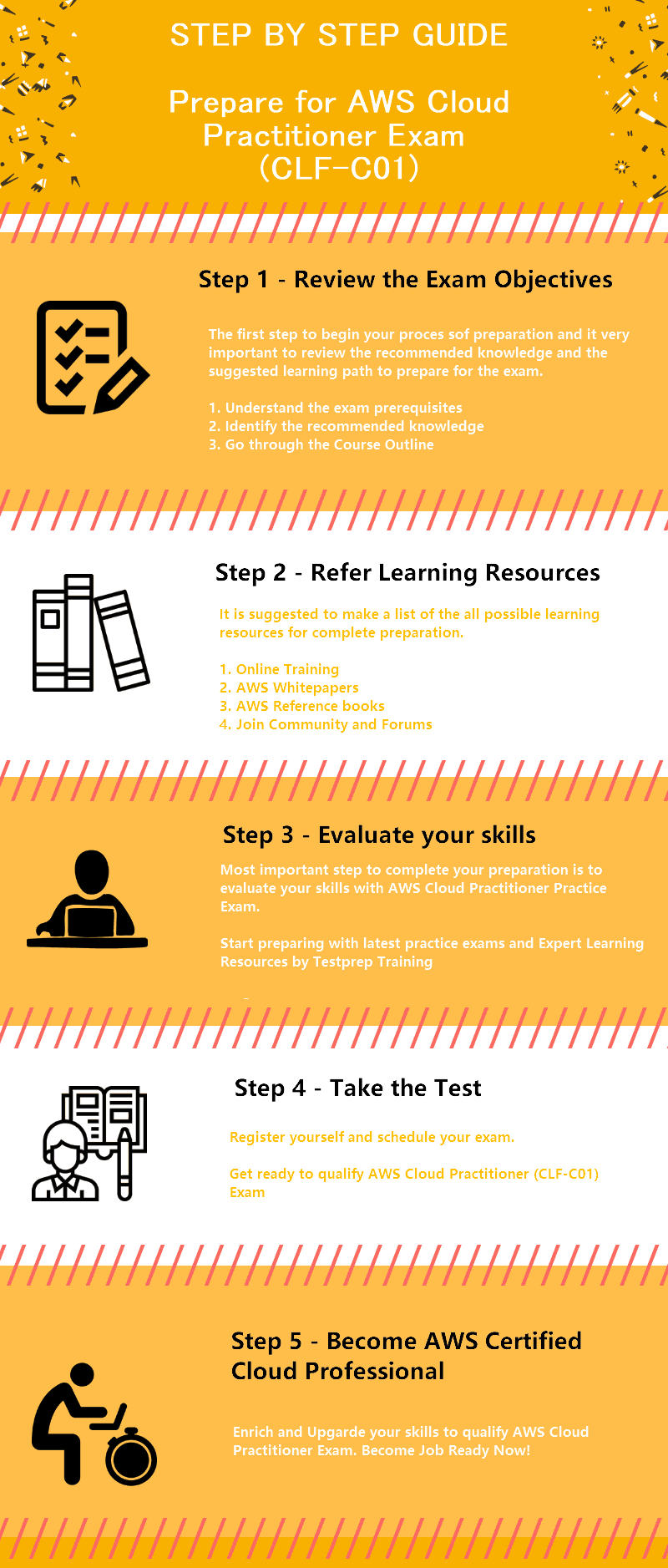
Review the Exam Objectives
Before, venturing on any journey, one must have a clear idea of what he/she is putting themselves into. With that being said, reviewing each and every exam objective becomes the most important part of your preparation. So, make sure you visit the Official website of AWS, to have a clear view. Since it is the most authentic site to provide any information regarding the CLF-C02 Exam. After you’ve gone through the basic exam details. It’s time to hit the exam guide.
Download Course Outline
The second most crucial step is to download the Course outline aka the Exam Guide. It consists of all the domains and topics of the examination. So, make sure to download the Course Outline. This allows you to prepare for the CLF-C02 Exam, keeping in mind all the objectives.

Exploring AWS Learning Paths
Now that you have downloaded the course outline, it’s time for you to go through AWS Learning Paths. This particular step will ensure that you have a great foundation before real learning begins. In other words, acquiring prior knowledge will be like a groundwork. Therefore, make sure to go through the suggested learning path.
AWS Cloud Practitioner Training
AWS Cloud Practitioner Essentials (Classroom)
This is fundamental-level, one-day, instructor-led classroom course. After this, the candidate learn the following –
- Learn what the cloud is and how it works
- Distinguish between cloud computing and deployment models
- Illustrate the AWS Cloud value proposition
- Understand the basic global infrastructure of the cloud
- Analyze and compare the different methods of interacting with AWS
- Describe and distinguish between AWS service domains
- Identifying appropriate solutions using AWS Cloud services
- Illustrate the Well-Architected Framework
- Describe basic AWS Cloud architectural principles
- Understand the Shared Responsibility model
- Demonstrate security services with the AWS cloud
- Define the billing, account management, and pricing models for the AWS platform
- Identifying future services and developments built on the cloud
AWS Cloud Practitioner Essentials (Second Edition)
This is a free digital course to understand the fundamentals of the AWS Cloud, build cloud skills, and prepare for the AWS Certified Cloud Practitioner exam. After this, the candidate will learn to do the following-
- Define what the AWS Cloud is and the basic global infrastructure
- Describe the key services on the AWS platform and their common use cases
- Describe basic AWS Cloud architectural principles
- Describe the basic security and compliance aspects of the AWS platform and the shared security model
- Define the billing, account management, and pricing models
- Identify sources of documentation or technical assistance (e.g., whitepapers, support tickets)
- Describe the AWS Cloud value proposition
- Describe basic/core characteristics of deploying and operating in the AWS Cloud
Online Learning Courses
If a candidate wishes to join an Online Course for the same. There are various courses available online. In fact, the internet is cluttered with so many courses. So, makes sure to find a suitable course, which is available in your price range. These courses provide you with online video study material, that can get digested easily. Also, they even provide the candidate with sample papers. So, you can try them out.
AWS Whitepapers & Learning Resources
After, this you must go through AWS whitepapers. With these, you will expand your knowledge of the cloud with AWS technical content. Also, you’ll find various technical whitepapers, technical guides, reference material, and reference architecture diagrams. But, we have narrowed it down to the following. So, make sure to go through the following-
- Overview of Amazon Web Services
- Architecting for the Cloud: AWS Best Practices
- How AWS Pricing Works
- Compare AWS Support Plans
Refer official AWS Whitepapers
1. Others:
Cloud best practices
AWS Pricing overview
Compare aws support plans
2. AWS hands on exercises:
You can find all the hands on exercises on the following link. You can practice the relevant exercises.
https://aws.amazon.com/getting-started/hands-on/
3. Learning Library:
https://www.aws.training/LearningLibrary?&search=&tab=view_all
4. AWS complete documentation:
https://docs.aws.amazon.com/index.html
AWS Reference Books
There are many reference books that are available for the AWS Cloud Practitioner Certification Exam. And, the few good ones are,
- The Beginners Guide to Amazon Web Services book by Dennis Hutten
- AWS Certified Cloud Practitioner Study Guide book by Ben Piper, David Clinton
- AWS Basics: Beginner’s Guide book by Gordon Wong
- Certified Cloud Practitioner Certification Guide book by Todd Montgomery
- Amazon Web Services for Dummies-by Bernard Golden
Join the Community/ Online Forum
Online forums and study groups are a great way to prepare for the certification exam. Therefore, feel free to get in touch with other candidates through study forums or online groups to ask a question related to the topic you’re having difficulty with.
However, it’s not something you have to join. It’s just something very subjective. Not to mention, these online groups help you stay equated with the other people who are also walking through the same path as yours. Moreover, you can also ask a question related to the topic you’re having difficulty with.
Self-evaluation Time
Finally, we’re on the last step for the preparatory guide. Further, this final step will give the candidate the exact insight of the topics in which they’re lacking. So, make sure you’re going through enough sample tests after you have gone through the entire syllabus. Most importantly, all the AWS Cloud Practitioner practice tests are designed to encounter the real exam environment around you. However, practice papers can be from various sources. Above all, remember the more you test yourself the better you’re going to become. Start Practicing for AWS Cloud Practitioner Exam Now!
As for the preparation part, candidates should avoid last-minute cramming sessions as it is rarely beneficial in the long term. If your experience is minimal or is limited to only certain areas of those related knowledge domains, then you should go for the study materials mentioned above in the guide to broaden your knowledge. And, we’re sure that you will be able to qualify the examination in the very first attempt.
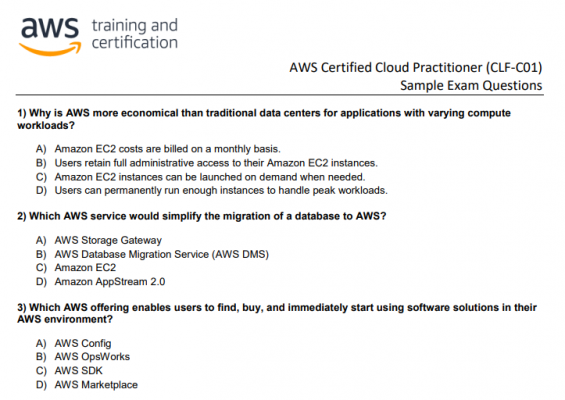
Refer Official AWS Sample Question
Learning Resources AWS Cloud Practitioner – Table of Contents
Domain 1: Cloud Concepts
1.1 Define the AWS Cloud and its value proposition
1.2 Identify aspects of AWS Cloud economics
1.3 List the different cloud architecture design principles
Domain 2: Security
2.1 Define the AWS Shared Responsibility model
2.2 Define AWS Cloud security and compliance concepts
2.3 Identify AWS access management capabilities
2.4 Identify resources for security support
Domain 3: Technology
3.1 Define methods of deploying and operating in the AWS Cloud
3.2 Define the AWS global infrastructure
3.3 Identify the core AWS services
3.4 Identify resources for technology support
Domain 4: Billing and Pricing
4.1 Compare and contrast the various pricing models for AWS
4.2 Recognize the various account structures in relation to AWS billing and pricing
4.3 Identify resources available for billing support
Link for free practice test – https://www.testpreptraining.com/aws-certified-cloud-practitioner-free-practice-test

